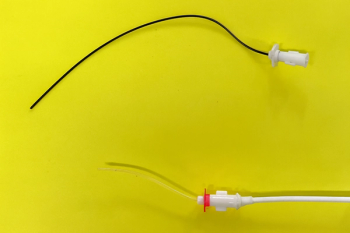
Evidence-based microalbuminuria testing (Proceedings)
Conventional urine dipsticks are the standard initial screening test for detection of proteinuria. Urine albumin concentration must be approximately 30 mg/dl or greater to be detected by this method.
Conventional urine dipsticks are the standard initial screening test for detection of proteinuria. Urine albumin concentration must be approximately 30 mg/dl or greater to be detected by this method. However, normal urine albumin concentration in dogs and cats is in fact significantly lower than this limit of detection: although there are slight differences between cats and dogs, the upper end of the reference range is approximately 1 mg/dl. The range between these numbers (1 - 30 mg/dl) is referred to as microalbuminuria (MAlb), whereas proteinuria greater than 30 mg/dl is referred to as overt proteinuria. Detection of microalbuminuria may therefore allow earlier diagnosis of pathologically increased urine protein excretion, which can occur with primary glomerular diseases or extra-renal inflammatory diseases that secondarily damage the kidneys. However, just as with overt proteinuria, microalbuminuria may be due to pre-glomerular, glomerular, or post-glomerular causes.
Further testing for primary or secondary glomerular diseases in patients with microalbuminuria should only occur once pre-glomerular and post-glomerular causes of proteinuria/albuminuria have been excluded. Pre-glomerular proteinuria may be due to functional (also called physiologic) proteinuria, or overload proteinuria. Functional proteinuria is usually benign, transient, and abates when the underlying cause is corrected. This class of proteinuria is poorly documented in veterinary medicine, but possible causes based on what is known in people include strenuous exercise (although one study in dogs did not support this), seizures, fever, extreme heat or cold, and venous congestion (i.e. congestive heart failure or hepatic fibrosis). Overload proteinuria occurs when the tubular resorptive capacity for certain proteins is exceeded, usually because serum concentrations of these proteins are abnormally increased. Diseases associated with overload proteinuria include Bence Jones proteinuria (light chains of immunoglobulins produced by multiple myeloma and some lymphomas), hemoglobinuria, and myoglobinuria. Post-glomerular proteinuria may be due to ANY cause of hemorrhage or inflammation in the ureters, bladder, urethra, or genital tract. Examples include bacterial infections and urinary tract neoplasia or uroliths, regardless of whether a secondary infection is present.
Microalbuminuria: Significance in People
There are several diseases in people where there is a strong association between MAlb and poor outcome. MAlb is a very strong prognostic indicator for eventual development of renal failure in diabetic patients. Presence of MAlb is also correlated with cardiovascular disease and mortality in all patients with diabetes mellitus, regardless of the type of diabetes. Successful therapy with ACE-inhibitors and better glycemic control slow the progression of MAlb to overt proteinuria, and decreases the likelihood of eventual azotemia and end-stage renal disease. Other inflammatory diseases associated with MAlb in people include some neoplasms, inflammatory bowel disease, and acute inflammatory conditions such as pancreatitis, myocardial infarction, and surgery. In many of these conditions it appears that the degree of MAlb correlates with the severity of the insult. This correlation is particularly evident in people with lung or breast cancer or lymphoma; in these patients presence and degree of MAlb correlates with histologic subtype, tumor burden, presence of metastatic disease, and prognosis.
Interest in the prevalence and significance of microalbuminuria (MAlb) in dogs and cats is derived from these strong associations in people and because the feline and canine ERD-HealthScreen® test point-of-care assays are available. Although a number of abstracts and papers have been published specifically looking at MAlb, there is still no formal consensus on how to proceed with a given result.
Microalbuminuria: Testing Recommendations in Dogs and Cats
Patients that usually DO NOT benefit from MAlb testing, or where MAlb work-up should be delayed until underlying causes are identified and treated:
• Patients with pyuria or bacteriuria
• Patients with confirmed lower urinary tract disease
• Patients with hyperglobulinemia suspected to be monoclonal in nature
• Patients where the UPC ratio has already been documented to be increased
• Apparently healthy patients where owners would not be willing to spend money on further diagnostics based on the results of MAlb testing
Patients who may benefit from MAlb testing include:
• Patients with renal failure and dipstick proteinuria, but which have normal UPCs
• Breeds of dogs with a high prevalence of hereditary glomerular disease (Shar-peis, Soft-coated Wheaten Terriers, etc.)
• Patients with diseases known to cause glomerular injury, and where therapy could be considered if MAlb positive but still UPC negative (heartworm disease, ehrlichiosis, etc.)
• Patients where occult disease is more likely (such as geriatric dogs and cats) and the owners would be willing to spend money for further diagnostics if the patient is MAlb-positive.
Unfortunately once MAlb is diagnosed it is still unclear when or how much further investigation is merited. Animals with positive results should first have UPC ratios performed to quantitate the severity of proteinuria. Breeds known to develop hereditary glomerular diseases should likely be monitored regularly, and if proteinuria/albuminuria worsens then renal biopsy or non-specific intervention should be considered. In dogs with unexpected, persistently positive ERD-HealthScreen® results it may be advised to screen for glomerular diseases and/or extra-renal inflammatory diseases. No doubt, long-term longitudinal studies evaluating the benefit of these recommendations are still needed. One very important study that still must be performed is determining whether age- and breed-specific reference ranges for MAlb are needed; some breeds appear more likely to have MAlb, particularly when they reach the adult or geriatric age range. Likewise, it is unknown whether therapeutic intervention in dogs with microalbuminuria is of any benefit. However, microalbuminuria and overt albuminuria/proteinuria are likely just different points in a single continuum for many diseases, and thus treating the two differently may likewise be a mistake.
THE ERD-HealthScreen® TEST
The ERD-HealthScreen® test (marketed by HESKA) is the only reliable point-of care test for determination of urine albumin concentration that is increased into the microalbuminuria (MAlb) range (1.0-30 mg/dl) but is still not high enough to be detected by standard protein dipsticks (overt proteinuria; >30 mg/dl). Although the SSA test may experimentally detect urine protein in the MAlb range the result is less definitive than the ERD-HealthScreen® test. The current reference range for MAlb may be inappropriate for all breeds and dog ages, but further studies are required before the reference range can be altered based on patient signalment. The ERD-HealthScreen® test is performed by dilution of a urine sample to a standard urine specific gravity, thus eliminating the variation between dogs and samples caused by urine concentration. However, the ERD-HealthScreen® is still only semi-quantitative, as results are reported as 'negative,' 'low positive,' 'medium positive,' or 'high positive.'
Urine protein in the MAlb range is abnormal. Reported studies using the ERD-HealthScreen® have shown that MAlb occurs in dogs with hereditary glomerulonephritis or nephritis, dogs with heartworm disease, dogs with some neoplasms, and dogs with a variety of other infectious or inflammatory conditions. In addition, in diseases where proteinuria is known to be associated with renal dysfunction/failure (heartworm disease, hereditary nephritis) MAlb is reliably detected weeks to months before the UPC becomes abnormal. Therefore it is clear that the ERD-HealthScreen® can be useful for early detection of pathologic proteinuria. In addition to its utility in the diagnosis of glomerular disease, in people the presence of MAlb is associated with poor outcome in many kidney diseases, and correlates with the likelihood of developing complications unassociated with the kidney. For example in some types of neoplasia MAlb correlates with higher tumor burden, some tumor histologic subtypes, and the presence of metastatic disease. MAlb also correlates with cardiovascular complications in human patients with hypertension. Similar associations in veterinary patients are being investigated.
Finally, it is unknown whether therapeutic intervention in dogs with ERD-HealthScreen® -confirmed MAlb is of any benefit. However, MAlb and overt albuminuria/proteinuria are likely just different points in a single continuum for many diseases, and thus treating the two differently may be a mistake. ACE-inhibitors are known to decrease proteinuria (as measured by the UPC) in dogs with naturally-occurring glomerular disease, and improve survival in experimental models of renal disease and in people. It is therefore likely that they are of benefit in dogs and cats with MAlb, but this assumption is not based on solid evidence in patients with naturally-occurring diseases. Despite the theoretical advantage, few if any nephrologists (including myself) recommend instituting therapy in dogs or cats with MAlb but no identifiable concurrent disease.
Newsletter
From exam room tips to practice management insights, get trusted veterinary news delivered straight to your inbox—subscribe to dvm360.





